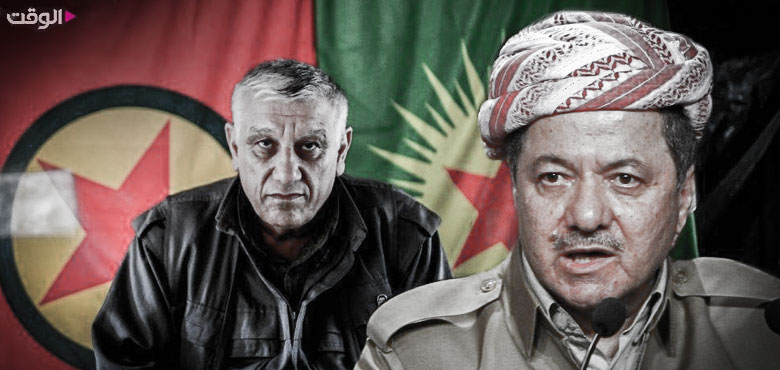Alwaght- The relations between the Kurdistan Democratic Party (KDP) and the Kurdistan Workers’ Party (PKK) in the past two months have reached a critical and tense stage. In the past few weeks, reports emerged about clashes between the Iraqi Kurdistan’s Peshmerga forces and the guerrilla forces of the terrorist PKK group.
Initially, sources affiliated with the autonomous region claimed that the PKK gunned down two power ministry’s employees in Duhok. In the most important development, on December 13 open clashes took place between Peshmerga and PKK militants in the Amedi neighborhood of Duhok, killing one Peshmerga trooper and injuring three PKK fighters.
However, the clashes between the two sides did not remain limited to Amedi. Rather, a new wave erupted on December 16, this time ignited by the Syrian Kurdish militants under the Democratic Union Party (PYD), the Syrian branch of the PKK. Deputy Minister of Peshmerga Affairs Serbest Lezgin at a press conference said that a 60-member unit affiliated with PYD attacked the Peshmerga forces with heavy and semi-heavy weapons after the latter blocked illegal entry of 8 PKK forces to Iraqi Kurdistan.
Now the question is that what is driving the new round of confrontation between the KDP and PKK? What instruments each of these parties have against each other? Three key issues should be addressed in answering these questions.
Sinjar agreement, the sparks in powered store
The crisis and tensions between the two Kurdish parties should be tracked to the 1990s. The PKK, founded in 1978 by Abdullah Ocalan, initiated its armed battle against Turkey in 1983. The party relocated its command center to northern Iraq in the late 1980s, and when in the early 1990s the Iraqi Kurdistan’s autonomy was established, the presence of the PKK in Qandil Mountains posed a source of troubles for the newly-founded Kurdish administration in the north. In the meantime, the cooperation of the KDP with Turkey in Ankara’s military campaigns made the party the top enemy of the PKK, giving rise to entrenched hostility.
Although in the late 1990s, this hostility saw a downturn and even after 2003, the year the US invasion ousted the Iraqi dictator Saddam Hussein, a level of secret and intangible cooperation was established between them, the exchanged feud and aversion never ended.
When the ISIS terrorist group emerged in Iraq in 2014, the PKK, understanding the existing vacuum of power, poured towards Sinjar, a town in Nineveh province, and formed the Sinjar Resistance Units (YBS). But the Barzanis, a powerful family controlling Erbil and holding the KRG, have always demanded the exit of the PKK from the region, only to face the party’s opposition. Finally, the Erbil-Baghdad agreement on the administration of Sinjar on October 10 paved the way for the expulsion of the PKK from the town. Now PKK finds itself a victim of a political game played by the KDP with the central Iraqi government, something fueling a new phase of tensions and clashes.
PKK and the push to make governance costly for the Barzanis
With the current situation and the upcoming occurrences considered, here are the most possible goals behind PKK’s entry to war against the KDP:
1. The first goal is taking revenge on the Barzanis for their intervention in expulsion of the PKK militants from Sinjar under the October deal between the central government and the Kurdish administration.
2. The second goal is increasing the pressures on the KDP. While the Barzani family is censured by the Kurdish region’s citizens and is accused of treason and profiteering due to its warm ties with Turkey as the archenemy of the Syrian as well as Iraqi Kurds and selling oil and granting special economic privileges to Ankara in return for family and party interests, the recent clashes will put the Barzanis in the center of blame for a “fratricidal” war and inflict damage on their legitimacy among the citizens.
3. The third goal is taking advantage of the legitimacy crisis the Barzanis have been facing over the past years due to the grave economic conditions and rife corruption that periodically sparks protests in Kurdistan. While it is not hidden that the PKK supports the popular anti-corruption and economic crisis demonstrations, Erbil accuses the PKK of playing an active role in the arrangement of the rallies and attacks on the government and party headquarters.
Erbil instruments to confront the PKK
As the PKK-KDP tensions heighten, the question is that what tools does the KDP, as the towering party in Erbil, have to counter the PKK? Five options seem to be at KDP’s disposal:
1. The KRG will possibly refer the PKK actions and violations to the Western actors in the so-called anti-ISIS western coalition which is the main backer of the Syrian Kurds and ask such players as the US, France, and Germany for intervention as a warning to the Syrian Democratic Forces’ commander Mazloum Kobani, an ally to the PKK.
2. Another choice is the possible entry of the Barzanis to a sophisticated military confrontation against the PKK in the Qandil Mountains, especially in Amedi.
3. In the next stages, if the PKK attacks continue, it is likely that the KDP, with the assistance and participation of Turkey, launches a new wave of joint attacks on the PKK positions in northern Iraq.
4. Another option is closing down the Sahila border crossing to the Syrian Kurds as the only lifeline of the Iraqi Kurdistan to the Syrian Kurds that can be used as a pressure card against the PKK.
5. Furthermore, the Barzanis can arrange direct talks with the PKK commander in the Qandil region Jamil Bayek over a ceasefire and management of tensions in the future.



























